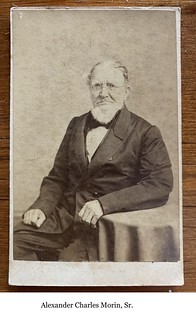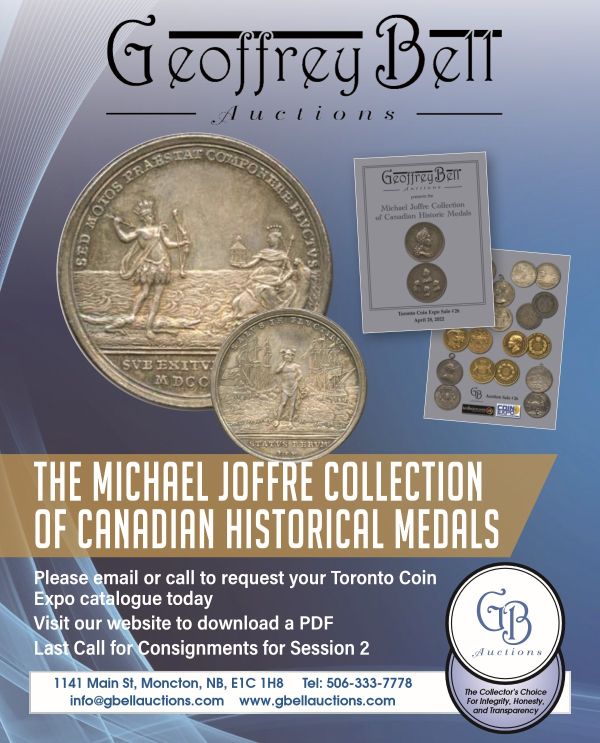
PREV ARTICLE
NEXT ARTICLE
FULL ISSUE
PREV FULL ISSUE
V25 2022 INDEX E-SYLUM ARCHIVE DIESINKERS ALEXANDER AND ANTHONY MORINAmerican Numismatic Biographies author Pete Smith submitted this article on the Morin family of diesinkers. Thanks! -Editor
Alexander / Anthony Morin
Most weeks I write about some name that is well known in numismatics. This week my topic is more obscure. In his book Who's Who Among American Medalists, D. Wayne Johnson mentions confusion between two diesinkers, Alexander and Anthony Morin. I have new information on both. My thanks to Julia Casey for assistance with the research.
Alexander Charles Morin, Sr. (1790-1879)
Alexander married Mary Harwood (1775-1839) on June 27, 1813. Their children were Cecelia Margaret (1817-1869), Anthony (1823-1892), Alexander Charles (1827-1904), Mary Ann (1831-), Caroline, and Louise. His wife is also listed in the 1850 census as Tacy Thomas Morin (1797-1883), an indication that he was apparently remarried between 1839 and 1850. Morin's work on medal dies may have been a small part of his business. Much more important was his production of dies for embossed leather book bindings. In the (Philadelphia) Public Ledger of May 25, 1852, he ran an ad as a Die Sinker at 86 Walnut Street. In 1856, he was on the northeast corner of 8th and Walnut, two blocks south and six blocks east of the second Mint.
In 1858, Boyd's co-partnership and residence business directory of Philadelphia City lists The 1860 census gives his profession as die sinker. In the 1850 and 1870 census, his name is spelled Moran. The 1870 Gopsill's Philadelphia Business Directory lists Morin, Alexander C., 302 Walnut. That year he ran an ad in the Public Ledger with an offer to sell the tools of a die sinker. He died (of old age) on November 12, 1879, and is buried in Lafayette Cemetery in Philadelphia. His death certificate indicates his profession as die sinker.
Alexander Charles Morin, Jr. (1827-1904)
Alexander was not a die sinker but is mentioned because he had the same name at the same time. He was born in Philadelphia on March 4, 1827, the son of Alexander and Mary. He married Elizabeth Catherine Slocumb (1848-1908) on December 23, 1867. Their children were Elizabeth (1868-1962), John (1870-1944), Cecelia (1872-1881), Alexander Francis (1881-1953), William Robert (1883-1969), and George Ellis (1885-1977). In the 1850 census he is listed in Louisville, Kentucky, as a carpenter. He moved to Houston in 1852 as a building contractor. Seeing a need for public notices, he founded the Daily Court Review in 1889. The paper has remained with the Morin family over four generations. Alexander died in Houston, Texas, on December 3, 1904, and is buried in Glenwood Cemetery in Houston.
Anthony C. Morin (1823-1892)
Anthony was born in Philadelphia in 1823, the son of Alexander and Mary. Anthony married Sarah Butcher (1828) on October 15, 1845. Their children were Ella (1848), Charles (1852), and Samuel (1858). In the 1850 and 1860 census he was listed as a silver chaser. In the 1870 census, Anthony is listed as a die cutter while his son, Charles is an apprentice to a die cutter. In the 1900 census, Charles and Samuel are both listed as die cutters. Neither are linked to known medals. Anthony served with the Pennsylvania 90th Regiment, Company D, from 1861 to 1864. He was severely injured in the jaw at Antietam on September 17, 1862, and mustered out as a Captain. The 1870 Gopsill's Philadelphia Business Directory lists Morin, Anthony, 101 S. 8th. This is the same as the 1858 address for his father. It is six blocks east of the second Mint and two blocks north of the current address for his father. He died in Philadelphia of pulmonary tuberculosis on May 13, 1892, and is buried at Mount Peace Cemetery in Philadelphia. His death certificate gives his profession as engraver.
References
The early classic references are no help. American Engravers and Their Works (1875) by William Spohn Baker does not list Morin. American Engravers on Copper and Steel (1907) by David McNeely Stauffer does not list Morin. Biographical Dictionary of Medalists, Vol IV (1909) by Leonard Forrer lists A. C. Morin without a first name.
The Morin Dies
Morin is credited as engraver for the Pennsylvania State Agricultural Society medal, Julian AM-65, first struck in 1855. At the bottom of the obverse is
The answer can be found in Miscellaneous Documents Read in The Legislature of the
Commonwealth of Pennsylvania, During the Session Which Commenced at Harrisburg, on the
Second Day of January, 1855. The report runs for 800 pages. Readers who wish the shorter story
may skip to page 791 and document 99 This indicates the cost paid to the United States Mint and confirms Alexander C. Morin as the diesinker.
Two dies have the A. C. M . initials. The Edmund B. Sullivan in American Political Badges and Medalists 1789-1892 attributes a Henry Clay medal (HC 1844-23) to Anthony C. Morin. I believe attribution to Anthony C. Morin has been based on speculation rather than contemporary documentation and these pieces are more likely the work of Alexander C. Morin. Can such documentation be found? Thanks! Can anyone help with these further questions? -Editor
Wayne Homren, Editor The Numismatic Bibliomania Society is a non-profit organization promoting numismatic literature. See our web site at coinbooks.org. To submit items for publication in The E-Sylum, write to the Editor at this address: whomren@gmail.com To subscribe go to: https://my.binhost.com/lists/listinfo/esylum All Rights Reserved. NBS Home Page Contact the NBS webmaster 
|


